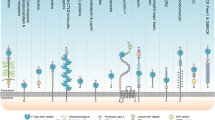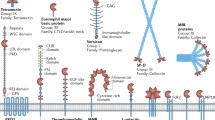Abstract
C-type lectins (CTLs) are a family of carbohydrate-recognition domain (CRD)-containing proteins that bind to ligands in a calcium-dependent manner. CTLs act as important components of insect innate immune responses, such as pattern recognition, agglutination, encapsulation, melanization, phagocytosis and prophenoloxidase activation, as well as gut microbiome homeostasis maintenance, to defend against pathogens. Besides, some insect CTLs can facilitate pathogen infection and colonization. In this review, we describe the properties of insect CTLs and focus on explaining their role in viral, bacterial, parasitic and fungal infections.
Y Zhu and X Yu are equally contributed to this work.
Access this chapter
Tax calculation will be finalised at checkout
Purchases are for personal use only
Similar content being viewed by others
References
Cheng G, Cox J, Wang P, Krishnan MN, Dai J, Qian F, Anderson JF, Fikrig E (2010) A C-type lectin collaborates with a CD45 phosphatase homolog to facilitate West Nile virus infection of mosquitoes. Cell 142(5):714–725. https://doi.org/10.1016/j.cell.2010.07.038
Cheng Y, Lin Z, Wang JM, Xing LS, Xiong GH, Zou Z (2018) CTL14, a recognition receptor induced in late stage larvae, modulates anti-fungal immunity in cotton bollworm Helicoverpa armigera. Dev Comp Immunol 84:142–152. https://doi.org/10.1016/j.dci.2018.02.010
Cohuet A, Osta MA, Morlais I, Awono-Ambene PH, Michel K, Simard F, Christophides GK, Fontenille D, Kafatos FC (2006) Anopheles and Plasmodium: from laboratory models to natural systems in the field. EMBO Rep 7(12):1285–1289. https://doi.org/10.1038/sj.embor.7400831
Dodd RB, Drickamer K (2001) Lectin-like proteins in model organisms: implications for evolution of carbohydrate-binding activity. Glycobiology 11(5):71R–79R
Drickamer K (1993) Evolution of Ca(2+)-dependent animal lectins. Prog Nucleic Acid Res Mol Biol 45:207–232
Drickamer K (1999) C-type lectin-like domains. Curr Opin Struct Biol 9(5):585–590
Gasmi L, Boulain H, Gauthier J, Hua-Van A, Musset K, Jakubowska AK, Aury JM, Volkoff AN, Huguet E, Herrero S et al (2015) Recurrent domestication by lepidoptera of genes from their parasites mediated by bracoviruses. PLoS Genet 11:e1005470
Gasmi L, Jakubowska AK, Ferre J, Ogliastro M, Herrero S (2018) Characterization of two groups of Spodoptera exigua Hubner (Lepidoptera: Noctuidae) C-type lectins and insights into their role in defense against the densovirus JcDV. Arch Insect Biochem Physiol 97(1). https://doi.org/10.1002/arch.21432
Geng T, Lv DD, Huang YX, Hou CX, Qin GX, Guo XJ (2016) JAK/STAT signaling pathway-mediated immune response in silkworm (Bombyx mori) challenged by Beauveria bassiana. Gene 595(1):69–76. https://doi.org/10.1016/j.gene.2016.09.043
Guzman MG, Gubler DJ, Izquierdo A, Martinez E, Halstead SB (2016) Dengue infection. Nat Rev Dis Primers 2(1)
Hillyer JF (2015) Integrated immune and cardiovascular function in pancrustacea: lessons from the insects. Integr Comp Biol 55(5):843–855. https://doi.org/10.1093/icb/icv021
Liu Y, Zhang F, Liu J, Xiao X, Zhang S, Qin C, Xiang Y, Wang P, Cheng G (2014) Transmission-blocking antibodies against mosquito C-type lectins for dengue prevention. PLoS Pathog 10(2):e1003931. https://doi.org/10.1371/journal.ppat.1003931
Liu K, Qian Y, Jung YS, Zhou B, Cao R, Shen T, Shao D, Wei J, Ma Z, Chen P, Zhu H, Qiu Y (2017) mosGCTL-7, a C-type lectin protein, mediates Japanese encephalitis virus infection in mosquitoes. J Virol 91(10). https://doi.org/10.1128/jvi.01348-16
Osta MA, Christophides GK, Kafatos FC (2004) Effects of mosquito genes on Plasmodium development. Science 303(5666):2030–2032. https://doi.org/10.1126/science.1091789
Pang X, Xiao X, Liu Y, Zhang R, Liu J, Liu Q, Wang P, Cheng G (2016) Mosquito C-type lectins maintain gut microbiome homeostasis. Nat Microbiol 1:16023. https://doi.org/10.1038/nmicrobiol.2016.23
Pees B, Yang W, Zarate-Potes A, Schulenburg H, Dierking K (2016) High innate immune specificity through diversified C-type lectin-like domain proteins in invertebrates. J Innate Immun 8(2):129–142. https://doi.org/10.1159/000441475
Rao XJ, Cao X, He Y, Hu Y, Zhang X, Chen YR, Blissard G, Kanost MR, Yu XQ, Jiang H (2015a) Structural features, evolutionary relationships, and transcriptional regulation of C-type lectin-domain proteins in Manduca sexta. Insect Biochem Mol Biol 62:75–85. https://doi.org/10.1016/j.ibmb.2014.12.006
Rao XJ, Shahzad T, Liu S, Wu P, He YT, Sun WJ, Fan XY, Yang YF, Shi Q, Yu XQ (2015b) Identification of C-type lectin-domain proteins (CTLDPs) in silkworm Bombyx mori. Dev Comp Immunol 53(2):328–338. https://doi.org/10.1016/j.dci.2015.07.005
Runsaeng P, Puengyam P, Utarabhand P (2017) A mannose-specific C-type lectin from Fenneropenaeus merguiensis exhibited antimicrobial activity to mediate shrimp innate immunity. Mol Immunol 92:87–98. https://doi.org/10.1016/j.molimm.2017.10.005
Sadd BM, Siva-Jothy MT (2006) Self-harm caused by an insect’s innate immunity. Proc Biol Sci 273(1600):2571–2574. https://doi.org/10.1098/rspb.2006.3574
Schnitger AK, Yassine H, Kafatos FC, Osta MA (2009) Two C-type lectins cooperate to defend Anopheles gambiae against gram-negative bacteria. J Biol Chem 284(26):17616–17624. https://doi.org/10.1074/jbc.M808298200
Shahzad T, Zhan MY, Yang PJ, Yu XQ, Rao XJ (2017) Molecular cloning and analysis of a C-type lectin from silkworm Bombyx mori. Arch Insect Biochem Physiol 95(3). https://doi.org/10.1002/arch.21391
Shin SW, Zou Z, Raikhel AS (2011) A new factor in the Aedes aegypti immune response: CLSP2 modulates melanization. EMBO Rep 12(9):938–943. https://doi.org/10.1038/embor.2011.130
Simoes ML, Mlambo G, Tripathi A, Dong Y, Dimopoulos G (2017) Immune regulation of plasmodium is anopheles species specific and infection intensity dependent. MBio 8(5). https://doi.org/10.1128/mbio.01631-17
Sun JJ, Lan JF, Zhao XF, Vasta GR, Wang JX (2017) Binding of a C-type lectin’s coiled-coil domain to the Domeless receptor directly activates the JAK/STAT pathway in the shrimp immune response to bacterial infection. PLoS Pathog 13(9):e1006626. https://doi.org/10.1371/journal.ppat.1006626
Tian YY, Liu Y, Zhao XF, Wang JX (2009) Characterization of a C-type lectin from the cotton bollworm, Helicoverpa armigera. Dev Comp Immunol 33(6):772–779. https://doi.org/10.1016/j.dci.2009.01.002
Wang P, Zhuo XR, Tang L, Liu XS, Wang YF, Wang GX, Yu XQ, Wang JL (2017a) C-type lectin interacting with beta-integrin enhances hemocytic encapsulation in the cotton bollworm, Helicoverpa armigera. Insect Biochem Mol Biol 86:29–40. https://doi.org/10.1016/j.ibmb.2017.05.005
Wang XW, Gao J, Xu YH, Xu JD, Fan ZX, Zhao XF, Wang JX (2017b) novel pattern recognition receptor protects shrimp by preventing bacterial colonization and promoting phagocytosis. J Immunol 198(8):3045–3057. https://doi.org/10.4049/jimmunol.1602002
Waterhouse RM, Kriventseva EV, Meister S, Xi Z, Alvarez KS, Bartholomay LC, Barillas-Mury C, Bian G, Blandin S, Christensen BM, Dong Y, Jiang H, Kanost MR, Koutsos AC, Levashina EA, Li J, Ligoxygakis P, Maccallum RM, Mayhew GF, Mendes A, Michel K, Osta MA, Paskewitz S, Shin SW, Vlachou D, Wang L, Wei W, Zheng L, Zou Z, Severson DW, Raikhel AS, Kafatos FC, Dimopoulos G, Zdobnov EM, Christophides GK (2007) Evolutionary dynamics of immune-related genes and pathways in disease-vector mosquitoes. Science 316(5832):1738–1743. https://doi.org/10.1126/science.1139862
Weis WI, Taylor ME, Drickamer K (1998) The C-type lectin superfamily in the immune system. Immunol Rev 163:19–34
Wongpanya R, Sengprasert P, Amparyup P, Tassanakajon A (2017) A novel C-type lectin in the black tiger shrimp Penaeus monodon functions as a pattern recognition receptor by binding and causing bacterial agglutination. Fish Shellfish Immunol 60:103–113. https://doi.org/10.1016/j.fsi.2016.11.042
Xia X, Yu L, Xue M, Yu X, Vasseur L, Gurr GM, Baxter SW, Lin H, Lin J, You M (2015) Genome-wide characterization and expression profiling of immune genes in the diamondback moth, Plutella xylostella (L.). Sci Rep 5:9877. https://doi.org/10.1038/srep09877
Yoshida S, Shimada Y, Kondoh D, Kouzuma Y, Ghosh AK, Jacobs-Lorena M, Sinden RE (2007) Hemolytic C-type lectin CEL-III from sea cucumber expressed in transgenic mosquitoes impairs malaria parasite development. PLoS Pathog 3(12):e192. https://doi.org/10.1371/journal.ppat.0030192
Yu XQ, Kanost MR (2000) Immulectin-2, a lipopolysaccharide-specific lectin from an insect, Manduca sexta, is induced in response to gram-negative bacteria. J Biol Chem 275(48):37373–37381. https://doi.org/10.1074/jbc.M003021200
Yu XQ, Gan H, Kanost MR (1999a) Immulectin, an inducible C-type lectin from an insect, Manduca sexta, stimulates activation of plasma prophenol oxidase. Insect Biochem Mol Biol 29(7):585–597
Yu XQ, Prakash O, Kanost MR (1999b) Structure of a paralytic peptide from an insect, Manduca sexta. J Peptide Res Off J Am Peptide Soc 54(3):256–261
Yu XQ, Tracy ME, Ling E, Scholz FR, Trenczek T (2005) A novel C-type immulectin-3 from Manduca sexta is translocated from hemolymph into the cytoplasm of hemocytes. Insect Biochem Mol Biol 35(4):285–295. https://doi.org/10.1016/j.ibmb.2005.01.004
Yu XQ, Ling E, Tracy ME, Zhu Y (2006) Immulectin-4 from the tobacco hornworm Manduca sexta binds to lipopolysaccharide and lipoteichoic acid. Insect Mol Biol 15(2):119–128. https://doi.org/10.1111/j.1365-2583.2006.00618.x
Zelensky AN, Gready JE (2005) The C-type lectin-like domain superfamily. FEBS J 272(24):6179–6217. https://doi.org/10.1111/j.1742-4658.2005.05031.x
Zhan MY, Shahzad T, Yang PJ, Liu S, Yu XQ, Rao XJ (2016) A single-CRD C-type lectin is important for bacterial clearance in the silkworm. Dev Comp Immunol 65:330–339. https://doi.org/10.1016/j.dci.2016.08.004
Zhang X, He Y, Cao X, Gunaratna RT, Chen YR, Blissard G, Kanost MR, Jiang H (2015) Phylogenetic analysis and expression profiling of the pattern recognition receptors: Insights into molecular recognition of invading pathogens in Manduca sexta. Insect Biochem Mol Biol 62:38–50. https://doi.org/10.1016/j.ibmb.2015.02.001
Zhou J, Fang NN, Zheng Y, Liu KY, Mao B, Kong LN, Chen Y, Ai H (2018) Identification and characterization of two novel C-type lectins from the larvae of housefly, Musca domestica L. Arch Insect Biochem Physiol 98(3):e21467. https://doi.org/10.1002/arch.21467
Zhu Y, Zhang R, Zhang B, Zhao T, Wang P, Liang G, Cheng G (2017) Blood meal acquisition enhances arbovirus replication in mosquitoes through activation of the GABAergic system. Nat Commun 8(1):1262. https://doi.org/10.1038/s41467-017-01244-6
Acknowledgements
This work was funded by grants from the National Key Research and Development Plan of China (2018ZX09711003-004-003 and 2018YFA0507202), the Natural Science Foundation of China (81730063 and 31825001), the Shenzhen San-Ming Project for prevention and research on vector-borne diseases (SZSM201611064).
Author information
Authors and Affiliations
Corresponding author
Editor information
Editors and Affiliations
Ethics declarations
The authors declare that they have no competing financial interests.
Rights and permissions
Copyright information
© 2020 Springer Nature Singapore Pte Ltd.
About this chapter
Cite this chapter
Zhu, Y., Yu, X., Cheng, G. (2020). Insect C-Type Lectins in Microbial Infections. In: Hsieh, SL. (eds) Lectin in Host Defense Against Microbial Infections. Advances in Experimental Medicine and Biology, vol 1204. Springer, Singapore. https://doi.org/10.1007/978-981-15-1580-4_5
Download citation
DOI: https://doi.org/10.1007/978-981-15-1580-4_5
Published:
Publisher Name: Springer, Singapore
Print ISBN: 978-981-15-1579-8
Online ISBN: 978-981-15-1580-4
eBook Packages: Biomedical and Life SciencesBiomedical and Life Sciences (R0)




